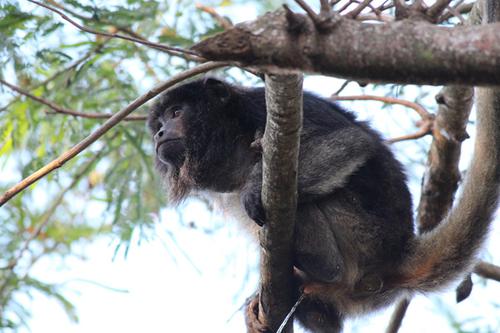当前位置:
X-MOL 学术
›
Am. J. Primatol.
›
论文详情
Our official English website, www.x-mol.net, welcomes your
feedback! (Note: you will need to create a separate account there.)
Bertiella sp. (Meyner, 1895) infection of Alouatta caraya (Humboldt, 1812) in urban and natural environments in Ñeembucú, southwest Paraguay.
American Journal of Primatology ( IF 2.0 ) Pub Date : 2020-06-29 , DOI: 10.1002/ajp.23166 John Kane 1, 2 , Rebecca L Smith 1, 3
American Journal of Primatology ( IF 2.0 ) Pub Date : 2020-06-29 , DOI: 10.1002/ajp.23166 John Kane 1, 2 , Rebecca L Smith 1, 3
Affiliation

|
Bertiella sp., a cestode known to infect a variety of hosts, including nonhuman primates and humans, was identified in Paraguay as early as 1895, but no systematic analysis of wild primates’ gastrointestinal parasites has ever been carried out in Paraguay. Increased urbanization in southwest Paraguay has pushed the Paraguayan howler monkey (Alouatta caraya) into anthropogenic habitats, particularly in the city of Pilar (Ñeembucú department), giving rise to greater potential for zoonotic transmission between wild primates and humans. From July to December 2018, fecal samples were noninvasively collected from 48 howlers inside Pilar (urban environment), the Pilar Military Base (intermediate environment), and a ranch 27 km outside Pilar in the humid Chaco (natural environment) and analyzed for Bertiella eggs and proglottids using macro‐analysis and formol‐ether sedimentation. Howlers living in the urban environment had the highest rates of Bertiella infection (50% prevalence), with considerably lower infection rates in the intermediate environment (6.25% prevalence) and natural habitats (0% prevalence). A χ2 goodness‐of‐fit test indicated a significant difference between the three habitat types (p = .007, χ2 = 10.005, df = 2). While the habitat seems to impact the frequency of infection, Bertiella was not observed to select for other factors such as age or sex of the primate host. Here we identified a significant increase in the frequency of Bertiella infection in an urban environment, which can then be further transmitted to new hosts with more direct primate contact. Bertiella infection has already been documented in humans in Paraguay, all of which were associated with close primate contact. As howlers move into more urban habitats due to urbanization and habitat fragmentation, Bertiella could be introduced into this new ecosystem and has the potential to cause further infections in humans.
中文翻译:

贝氏杆菌 (Meyner,1895年)在巴拉圭西南部的Ñeembucú市和自然环境中感染了Alouatta caraya(Humboldt,1812年)。
早在1895年就在巴拉圭发现了Bertiella sp。,一种已知会感染各种宿主(包括非人类灵长类动物和人类)的c,但从未在巴拉圭进行过野生灵长类动物胃肠道寄生虫的系统分析。巴拉圭西南部城市化进程的加快,将巴拉圭how猴(Alouatta caraya)推入了人为栖息地,尤其是在皮拉尔市(Ñeembucú部),这导致了野生灵长类动物与人之间人畜共患病传播的更大潜力。从2018年7月至2018年12月,从Pilar(城市环境),Pilar军事基地(中级环境)和潮湿Chaco(自然环境)Pilar以外27公里的牧场中的48只吼声中无创收集粪便样本并进行分析利用宏观分析和甲醚沉淀法对Bertiella卵和前睾丸进行分析。生活在城市环境中的咆哮者感染Bertiella的比例最高(患病率为50%),而在中间环境(患病率为6.25%)和自然栖息地(患病率为0%)中,其感染率要低得多。甲χ 2拟合优度检验表示的三个生境类型之间的显著差异(p = 0.007,χ 2 = 10.005,DF = 2)。虽然栖息地似乎会影响感染的频率,但是贝蒂氏菌没有观察到选择其他因素,例如灵长类动物宿主的年龄或性别。在这里,我们发现城市环境中Bertiella感染的频率显着增加,然后可以通过更直接的灵长类动物接触进一步传播给新宿主。在巴拉圭的人类中已发现Bertiella感染,所有这些感染都与灵长类动物密切接触有关。由于城市化和栖息地破碎,咆哮者进入更多的城市栖息地,因此Bertiella可能会被引入这个新的生态系统中,并有可能导致人类进一步感染。
更新日期:2020-08-26
中文翻译:

贝氏杆菌 (Meyner,1895年)在巴拉圭西南部的Ñeembucú市和自然环境中感染了Alouatta caraya(Humboldt,1812年)。
早在1895年就在巴拉圭发现了Bertiella sp。,一种已知会感染各种宿主(包括非人类灵长类动物和人类)的c,但从未在巴拉圭进行过野生灵长类动物胃肠道寄生虫的系统分析。巴拉圭西南部城市化进程的加快,将巴拉圭how猴(Alouatta caraya)推入了人为栖息地,尤其是在皮拉尔市(Ñeembucú部),这导致了野生灵长类动物与人之间人畜共患病传播的更大潜力。从2018年7月至2018年12月,从Pilar(城市环境),Pilar军事基地(中级环境)和潮湿Chaco(自然环境)Pilar以外27公里的牧场中的48只吼声中无创收集粪便样本并进行分析利用宏观分析和甲醚沉淀法对Bertiella卵和前睾丸进行分析。生活在城市环境中的咆哮者感染Bertiella的比例最高(患病率为50%),而在中间环境(患病率为6.25%)和自然栖息地(患病率为0%)中,其感染率要低得多。甲χ 2拟合优度检验表示的三个生境类型之间的显著差异(p = 0.007,χ 2 = 10.005,DF = 2)。虽然栖息地似乎会影响感染的频率,但是贝蒂氏菌没有观察到选择其他因素,例如灵长类动物宿主的年龄或性别。在这里,我们发现城市环境中Bertiella感染的频率显着增加,然后可以通过更直接的灵长类动物接触进一步传播给新宿主。在巴拉圭的人类中已发现Bertiella感染,所有这些感染都与灵长类动物密切接触有关。由于城市化和栖息地破碎,咆哮者进入更多的城市栖息地,因此Bertiella可能会被引入这个新的生态系统中,并有可能导致人类进一步感染。











































 京公网安备 11010802027423号
京公网安备 11010802027423号